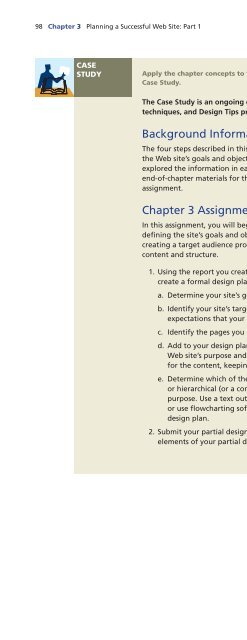(Shelly Cashman Series) Gary B. Shelly, H. Albert Napier, Ollie N. Rivers-Web design_ introductory concepts and techniques -Cengage Learning (2008)
Create successful ePaper yourself
Turn your PDF publications into a flip-book with our unique Google optimized e-Paper software.
98 Chapter 3 Planning a Successful <strong>Web</strong> Site: Part 1<br />
CASE<br />
STUDY<br />
Apply the chapter <strong>concepts</strong> to the ongoing development process in <strong>Web</strong> <strong>design</strong> with the<br />
Case Study.<br />
The Case Study is an ongoing development process using the <strong>concepts</strong>,<br />
<strong>techniques</strong>, <strong>and</strong> Design Tips presented in each chapter.<br />
Background Information<br />
The four steps described in this chapter covered a lot of material — from defining<br />
the <strong>Web</strong> site’s goals <strong>and</strong> objectives to planning a site’s structure. If you have carefully<br />
explored the information in each step <strong>and</strong> have worked your way through the<br />
end-of-chapter materials for this chapter, you are ready to tackle this chapter’s<br />
assignment.<br />
Chapter 3 Assignment<br />
In this assignment, you will begin to create your own formal <strong>Web</strong> site <strong>design</strong> plan by<br />
defining the site’s goals <strong>and</strong> objectives, writing a formal purpose statement, <strong>and</strong><br />
creating a target audience profile <strong>and</strong> needs assessment. You will also plan its general<br />
content <strong>and</strong> structure.<br />
1. Using the report you created in the Chapter 2 Case Study as your starting point,<br />
create a formal <strong>design</strong> plan for your site.<br />
a. Determine your site’s goals <strong>and</strong> objectives <strong>and</strong> draft the site’s purpose statement.<br />
b. Identify your site’s target audience(s) <strong>and</strong> determine the wants, needs, <strong>and</strong> likely<br />
expectations that your site’s <strong>design</strong> <strong>and</strong> content can satisfy for that audience.<br />
c. Identify the pages you initially plan to include at your site.<br />
d. Add to your <strong>design</strong> plan a list of value-added content that will help achieve your<br />
<strong>Web</strong> site’s purpose <strong>and</strong> satisfy target audience needs. Identify possible sources<br />
for the content, keeping in mind the copyright issues discussed in Chapter 2.<br />
e. Determine which of the three <strong>Web</strong> site structures — linear/tutorial, r<strong>and</strong>om,<br />
or hierarchical (or a combination of structures) — will best further your site’s<br />
purpose. Use a text outline, or manually draw the structure, create a storyboard,<br />
or use flowcharting software to illustrate your site’s structure as part of your<br />
<strong>design</strong> plan.<br />
2. Submit your partial <strong>design</strong> plan to your instructor. Be prepared to discuss the<br />
elements of your partial <strong>design</strong> plan in class.


